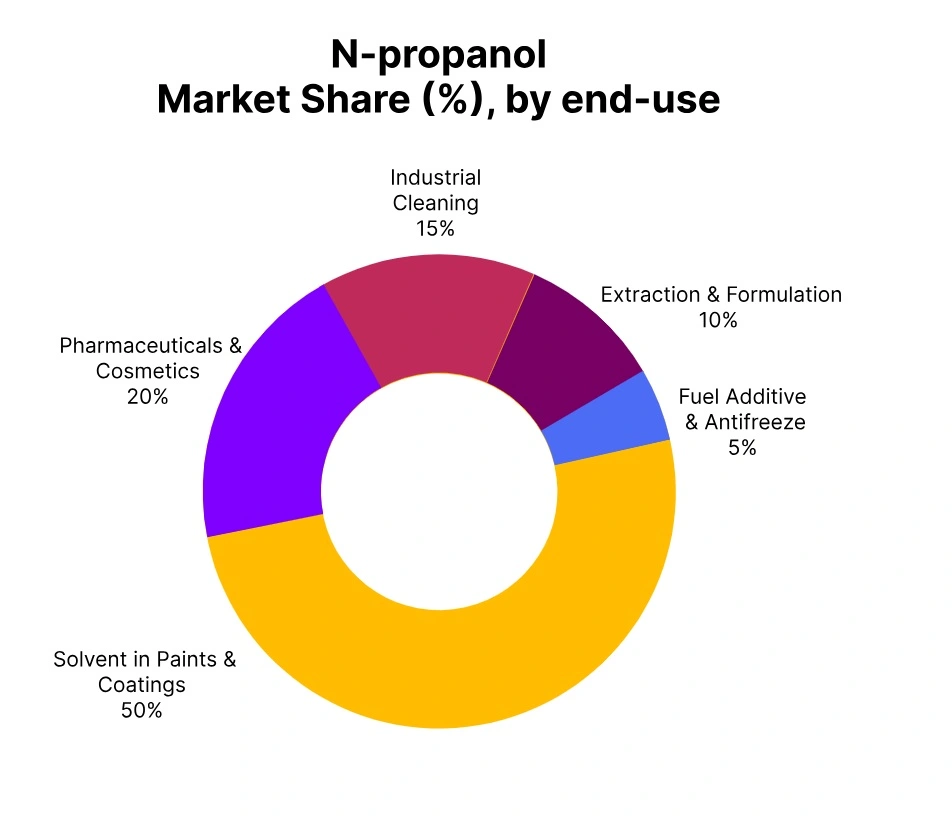Price-Watch’s most active coverage of n-Propanol price assessment:
- IG (99.5%) FOB Shanghai, China
- IG (99.5%) CIF Haiphong (China), Vietnam
- IG (99.5%) CIF Buenos Aires (China), Argentina
- IG (99.5%) CIF Manila (China), Philippines
- IG (99.5%) CIF Nhava Sheva (China), India
- IG (99.5%) Ex Kandla, India
n-propanol Price Trend Q3 2025
The n-propanol market on a global level experienced modest n-propanol price trend fluctuations in Q3 2025, in the range of 2-5%, due to a steady feedstock environment (propylene, acetone) despite crude oil price likelihood, with demand from pharmaceutical, paints, and coatings holding the market stable.
There were some pressures behind logistics challenges and rising freight activity costs, however, stable production and continued capacity expansions were more important and outweighed any impacts related to this change.
China
N-propanol export prices FOB Shanghai, China, Grade- Industrial Grade (99.5% min).
According to Price-Watch, in Q3 2025, n-Propanol prices in China dropped 8.64% from the previous quarter, Q2 2025. The n-Propanol price trend in China primarily followed a downward path due to declining demand in the automotive, coatings, and chemical sectors, where many participants had reduced output and consumption when compared to earlier in the year.
Prices had been mostly stable when production was nearly at full capacity, but then the market experienced an oversupply, which was a leading factor contributing to the significant price decline. Increased freight expenses and the ongoing disruption of global supply chains were additional pressure points on n-propanol pricing.
In September 2025, the pricing of n-propanol in China, was nonetheless showing a continuing downward trend fueled by weak demand and oversupply. Price volatility is anticipated to remain into the coming months, with recovery from the backlog being dependent on downstream demand and feedstock pricing fluctuations.
Vietnam (CIF from China)
N-propanol Import prices CIF Haiphong, Vietnam, Grade- Industrial Grade (99.5%).
In the third quarter of 2025, prices for n-Propanol in Vietnam fell by 8.25% compared to the second quarter of 2025. The trading fundamentals for n-Propanol pricing in Vietnam was affected by lower demand in key downstream industries, particularly automotive and textiles, which faced production delays, in addition to oversupply in the region and higher freight costs, which led to a fall in n-Propanol prices.
Although production levels were stable, weak demand in core sectors contributed to the declining price environment. n-Propanol price trends fell further in September 2025 as part of the weakening market conditions. As the outlook is uncertain as we head into the next quarter, prices are expected to continue to weaken further, unless there is a positive shift in market demand.
Argentina (CIF from China)
N-propanol Import prices CIF Buenos Aires, Argentina, Grade- Industrial Grade (99.5%).
In Q3 2025, n-Propanol prices in Argentina witnessed a 2.47% increase from Q2 2025. The n-Propanol price trend in Argentina was reinforced by gradual demand from the country’s pharmaceutical and automotive sectors which continued production despite challenges globally. The rise in prices of n-Propanol was attributed to an increase in freight costs from China as well as higher upstream prices, especially for propylene, which contributed to rises in production costs.
n-Propanol prices in Argentina in September 2025 continued a trend to sluggish prices, which reflected stable demand and tighter supply. The market is expected to continue upward moving forward, with prices likely to be supported by steady demand from key sectors.
Philippines (CIF from China)
N-propanol Import prices CIF Manila, Philippines, Grade- Industrial Grade (99.5%).
In Q3 2025, n-Propanol prices in the Philippines dropped by 10.95% compared to 2Q 2025. Lower demand from major end-users in coatings and chemicals and associated lower production levels drove the n-Propanol price trend. Higher freight also compounded the situation. Oversupply and weak domestic consumption contributed to the larger price drop.
Additionally, n-Propanol prices in the Philippines continued to decline in September 2025 due to lower demand and weak market conditions. The expectation for the next quarter is uncertain, but further declines in prices are anticipated unless demand increases.
Ex-Kandla
N-propanol Ex-prices Ex-Kandla, India, Grade- Industrial Grade (99.5%).
In the third quarter of 2025, n-Propanol prices at Ex-Kandla experienced a decrease of 4.41% compared to the second quarter of 2025. The n-Propanol price trend has been affected by deterred demand from the downstream automotive and chemical sectors, which has slowed production. Elevated freight rates and a reduction in export demand added further downward pressure to the price.
The sluggishness in consumption from key downstream industries in conjunction with oversupply conditions in the region have contributed to the price decline. n-Propanol prices in September 2025 at Ex-Kandla continued to lower in price, following the general trend of the outside market. The view for the fourth quarter of 2025 is cautious from a pricing perspective with the outlook for further price pressure unless demand returns in downstream industries.




